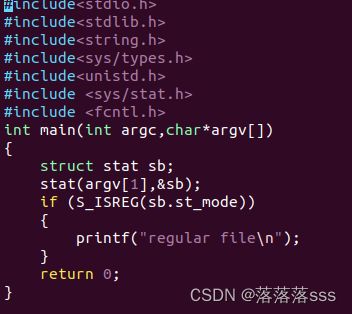linux的stat/lstat函数和目录遍历函数使用
stat函数:
作用:获取文件属性
函数原型:int stat(const char *pathname, struct stat *statbuf);
返回值:成功返回0
失败返回-1
struct stat {
dev_t st_dev; //文件设备编号
ino_t st_ino; //节点
mode_t st_mode; //文件的类型和存取的权限
nlink_t st_nlink; //连到该文件的硬链接数目,刚建立的文件值为1
uid_t st_uid; //用户ID
gid_t st_gid; //组ID
dev_t st_rdev; //设备类型
off_t st_size; //文件大小(字节数)
blksize_t st_blksize; //块大小
blkcnt_t st_blocks; //块数
struct timespec st_atim; //最后一次访问时间
struct timespec st_mtim; //最后一次修改时间
struct timespec st_ctim; //最后一次改变时间(指属性)
}
这是建立的stat.c文件
编译后可以用来访问test.log的属性。
通过以下操作可以访问文件的类型:
stat(pathname, &sb);
if ((sb.st_mode & S_IFMT) == S_IFREG) {
/* Handle regular file */
}
S_IFSOCK 0140000 socket
S_IFLNK 0120000 symbolic link
S_IFREG 0100000 regular file
S_IFBLK 0060000 block device
S_IFDIR 0040000 directory
S_IFCHR 0020000 character device
S_IFIFO 0010000 FIFO

成功:
或者:
stat(pathname, &sb);
if (S_ISREG(sb.st_mode)) {
/* Handle regular file */
}
S_ISREG(m) is it a regular file?
S_ISDIR(m) directory?
S_ISCHR(m) character device?
S_ISBLK(m) block device?
S_ISFIFO(m) FIFO (named pipe)?
S_ISLNK(m) symbolic link? (Not in POSIX.1-1996.)
S_ISSOCK(m) socket? (Not in POSIX.1-1996.)
成功:
通过以下操作可以访问文件的权限:
stat(pathname, &sb);
if(sb.st_mode&S_IRUSR) 为真表示用户可读
if(sb.st_m&S_IWUSR) 为真表示用户可写
if(sb.st_mode&S_IXUSR) 为真表示用户可执行
if(sb.st_mode&S_IROTH) 为真表示其他人可读
if(sb.st_mode&S_IRGRP) 为真表示所属组可读
成功:
注意:使用stat函数时,获取软连接文件的属性时获取的是被指向文件的属性,而不是连接文件本身。
所以要使用lstat函数,可以获取软连接文件本身的属性
目录遍历函数:
opendir :打开目录
DIR *opendir(const char *name);
使用:先建立一个DIR *pDir=NULL;
然后pDir=opendir(const char *name);
readdir:循环读取目录项
struct dirent *readdir(DIR *dirp);
使用:先建立一个struct dirent *pDent=NULL;
通过while((pDent=opendir(pDir))!=NULL)来循环读取目录里的内容
以下是struct dirent的内容
struct dirent {
ino_t d_ino; /* Inode number */
off_t d_off; /* Not an offset; see below */
unsigned short d_reclen; /* Length of this record */
unsigned char d_type; /* Type of file; not supported
by all filesystem types */
char d_name[256]; /* Null-terminated filename */
};
closedir :关闭目录
int closedir(DIR *dirp);







